Ars Electronica x Upper Austria University of Applied Sciences Hagenberg Campus
In collaboration with the Upper Austria University of Applied Sciences’ Hagenberg Campus, the Expanded Animation symposium carries on a process launched in 2013: to map the wide-ranging domain of animated imagery beyond well-trodden paths. This year’s symposium, under the title Tectonic Shift, offers several panel discussions on current trends in the extended field of computer animation. This year’s central question is: “What fundamental changes in conception, production and reception are discernible, and how does the Covid19 pandemic fit into this context?”
The 9th edition of the Expanded Animation symposium series will once again focus on current and future trends at the intersection of animation, art and technology during the Ars Electronica media art festival (September 8-12). On the first two days, international artists, researchers and developers will discuss current processes of change in the expanded field of animation under the motto Tectonic Shift. The central question is: What fundamental changes in conception, production and reception are discernible, and how does the Covid19 pandemic fit into this context? In addition, the winners from the Computer Animation category will give insights into their work in the Prix Forum. On the third day, the Synaesthetic Syntax symposium, launched in 2020, will enter its second round. As in 2020, the Hagenberg campus of the University of Applied Sciences Upper Austria will be the hub for the 3-day virtual event.
Tectonic Shift
For 35 years now, the Prix Ars Electronica international competition has represented an up-to-date survey of media art. Since then, prizes have been awarded in 13 categories. The Computer Animation category is one of the oldest, along with Computer Graphics (until 1994) and Computer Music. As the development of the media art competition shows, this is a dynamic process: new categories have emerged, some have merged, others have drifted apart or vanished. The thematic fields of animation, sound, interaction, digital communities, real-time, virtual reality, games or artificial intelligence collide and rub against each other, the boundaries are fragile and blurred. How do the different disciplines come together? Do they disappear into a diffuse unity, or is their special substance still recognizable?



